Thinking back on my iRacing oval career, it sometimes feels like an out-of-body experience. Or perhaps more aptly, that some other, more talented oval driver took over my body whenever it came time to turn left.
That’s the best explanation I can fathom for how a sim racer who, despite growing up on the Papyrus NASCAR games, never found much success on those earlier titles yet was able to leap up the oval ladder on iRacing and find success driving the Cup Series cars almost immediately in the Power Series.
I was able to discount my first few wins due to the circumstances. I won in my second start, but it was at Watkins Glen, where ringers can always shine. And I won at Chicagoland in the second race of my first full season, but had a lucky strategy call pay off and move me from the edge of the top ten into the lead.
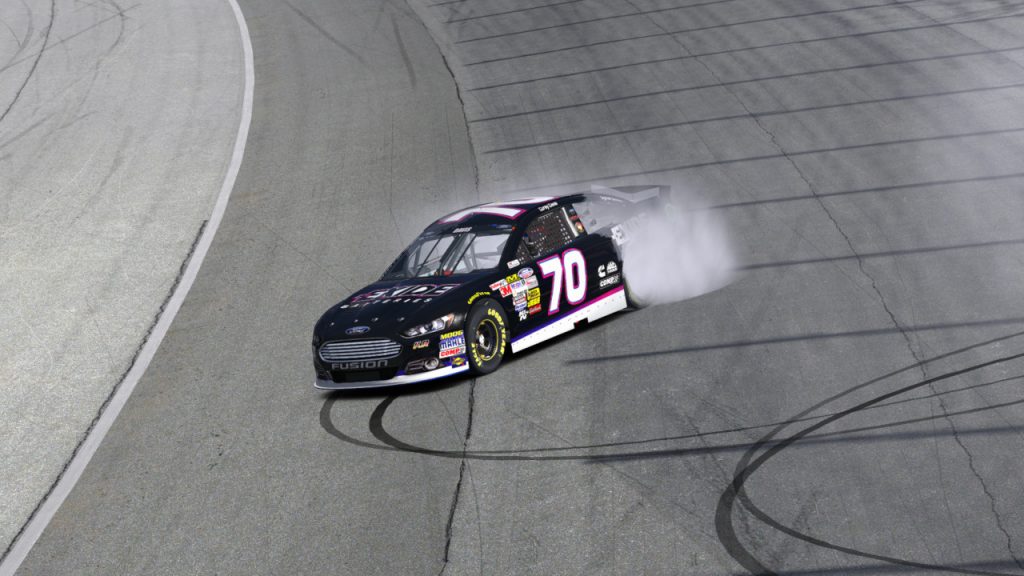
As time went on and I kept running well, including three straight wins in my rookie season, my oval racing chops began to seem undeniable, even if I was still in denial myself.
After 21 Power Series wins and two championships, as well as another in the truck-based Stars Series, my oval racing résumé feels full — well, aside from that restrictor plate win that always eluded me.
And even if I have no idea how I got there, I could easily choose many of those races as some of my best drives. There was my first fuel-mileage win at Rockingham, a runaway win in my first race at the repaved Phoenix, and a pair of stock car wins at Indianapolis to complement my 500 triumph.
But it’s another race at the Brickyard that didn’t end in victory lane that makes the #4 spot on the list of my ten best drives.
4. Power Series at Indianapolis – May 15, 2016
Frankly, any of my three championship-clinching races could have landed on this list. In the past, I’ve written about the other two: my first Power Series title run at Las Vegas and my fuel-saving Stars Series win at Homestead.
Because of the excitement of those races — a last-corner pass to take the title on a tiebreaker, and a truck win while storms raged all around me — my second Power Series championship drive at Indy seems tame by comparison.
But of the three, it’s probably the one that stressed me the most, and in some ways, it includes shades of the other two and how I used a bit of smart strategy, in-car mental math, and some focused driving to elevate my performance and take home the title.
Understanding why this was such a tough race requires backing up four months to the start of the season. Just like the NASCAR Cup Series in 2018 was marked by the dominance of “the Big Three” of Kyle Busch, Kevin Harvick, and Martin Truex Jr., the Power Series’ eleventh season saw three drivers win 12 of the 17 races.
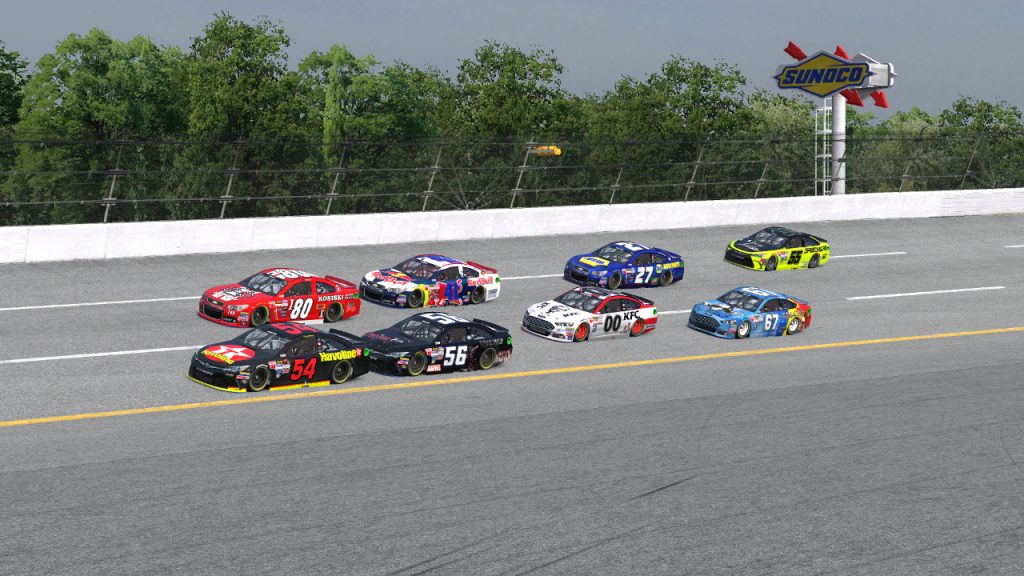
Tim Johnston, my Daytona 24 hour-winning teammate from earlier that year, opened that season with a win and racked up three more, with just four finishes outside the top five.
Mike Kelley, a long-time sim racing opponent of mine with whom I had a great rivalry but also tremendous respect, hit his stride mid-season with four wins in five races
And then there was me — arguably the weakest of the three statistically with the fewest laps led and laps completed, the latter due to a lap-1 crash at Chicagoland.
I won the two road races at Watkins Glen and Laguna Seca, and added short oval wins at Milwaukee and Iowa. But the bigger tracks hadn’t been my forte all season, and the finale was at one of the biggest of them all — Indianapolis.
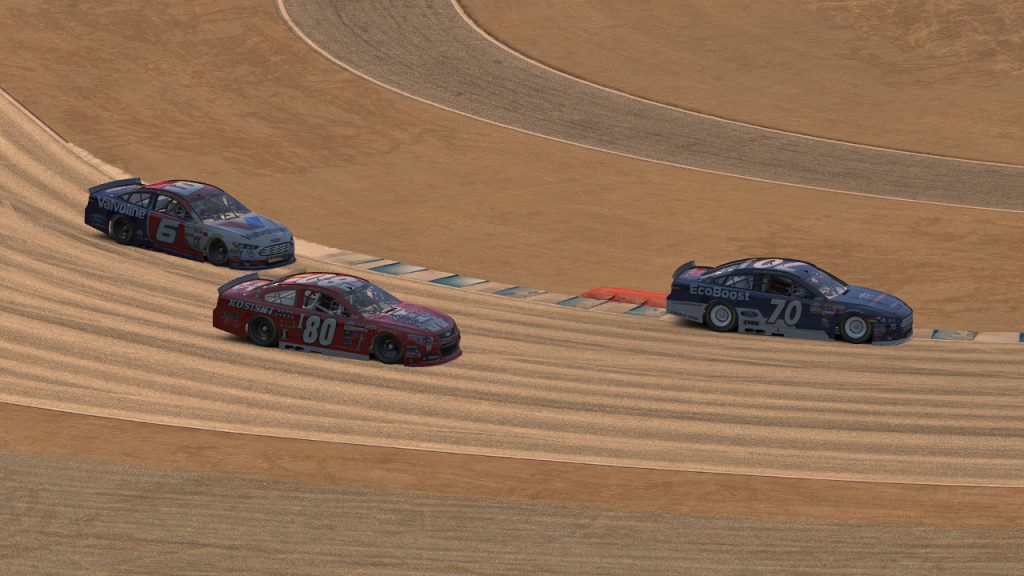
Entering the race, I had a narrow two-point advantage over Mike and nine over Tim thanks to a better result at Talladega a few weeks earlier. But with such small margins and bonus points on offer, especially for the race winner, I knew the title was far from sewn up entering Indy.
As was custom in each of my championship bids, I spent the week beforehand running numbers in my head. Instead of counting sheep at night, I counted points, and it was no more helpful at putting me to sleep.
On race day, my first break came in qualifying. I would start second, ahead of both Tim and Mike, and just maybe have a chance of leading a lap early on, which would be an extra point in the bag for me.
Unfortunately for me, one of the race’s spoilers had a different idea. Matt Delk entered the race fourth in points and had a successful season by all accounts, with four poles and a win to his name. But outside of championship contention, his focus was on first place in the finale, which is exactly where he started.
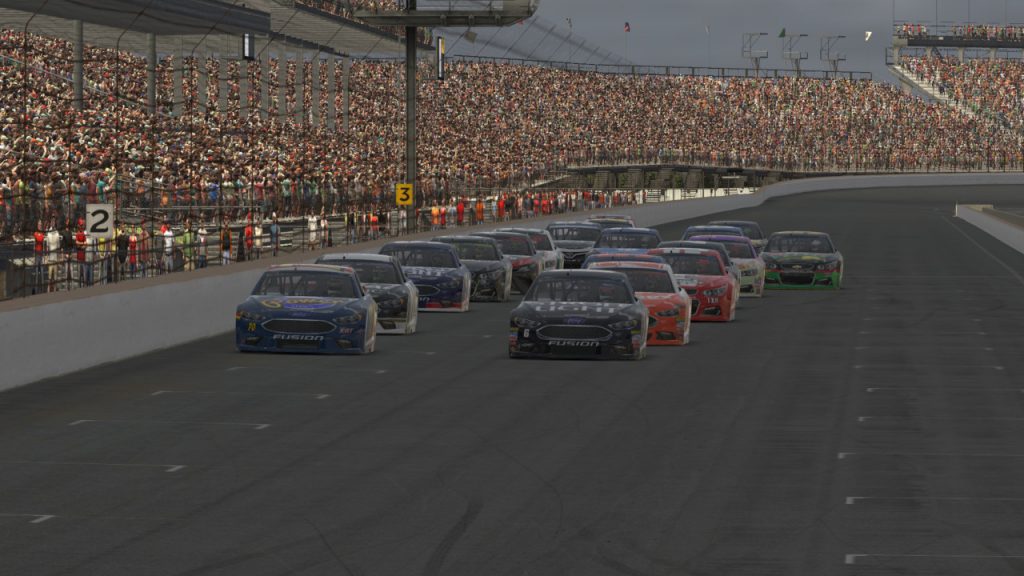
Matt was one of several drivers who could take potentially points away from me by slotting in between me and my competitors. My best hope was for Matt to stay up front and dominate the race.
The first run went largely to plan, with Matt leading and me in second. But two cautions between laps 15 and 25 put my hopes in increasing jeopardy. On the restart after the first caution, Tim and Mike both got around me.
I raced Mike hard, with the two of us running side-by-side for half a lap before I finally surrendered the spot in turn 2. Although every position was important, a crash while racing unnecessarily close just a quarter of the way through the race would have become an easy championship win for Tim.
The next caution flew just a lap later, and Matt pitted while Tim, Mike, and I stayed out. My worries about the dreaded spoiler scenario then returned: a fast driver like Matt on slightly fresher tires could have easily separated me from my rivals.
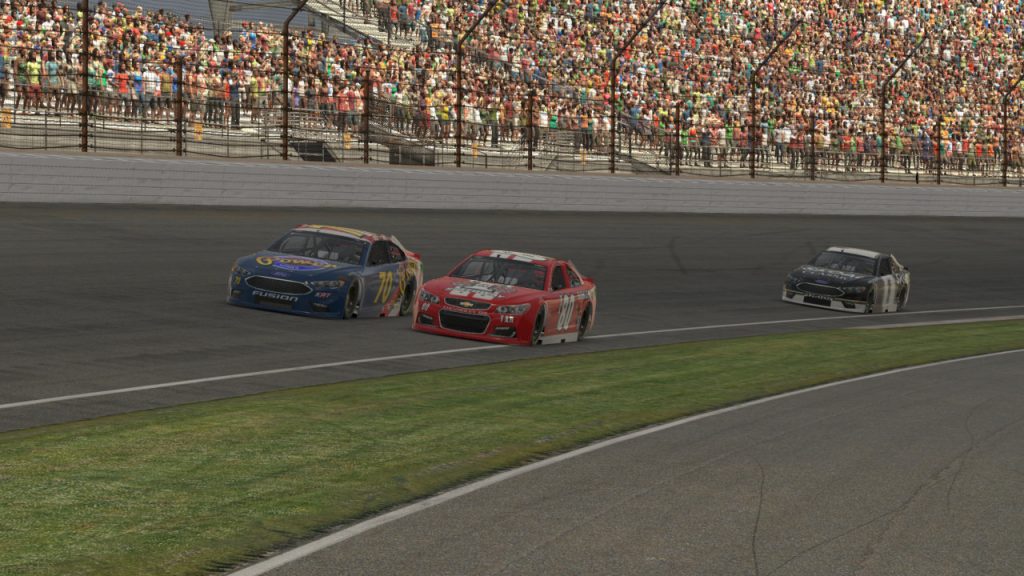
As the race entered its caution-free final 55 laps, it took Matt longer than expected to work through traffic, so I was in a relatively safe spot simply following Mike. It had become clear that we both had a similar pace, so if I stayed close and copied every move he made — including his pit strategy — I figured I’d be fine.
A wrench was thrown into my plans during the first round of green-flag pit stops. Tim ducked into the pits early, handing the lead — and a bonus point — to Mike. Just copying him was no longer enough. To be safe, I needed to lead a lap as well.
That meant either passing Mike or staying out longer than any of the leaders during the final round of stops twenty-some laps later.
At first, I pinned my hopes on the former. Mike and I pitted at the same time, then raced side-by-side onto the narrow access road on the inside of turn 1. I barely had a bumper ahead, and against any other driver, Mike might have forced the issue.
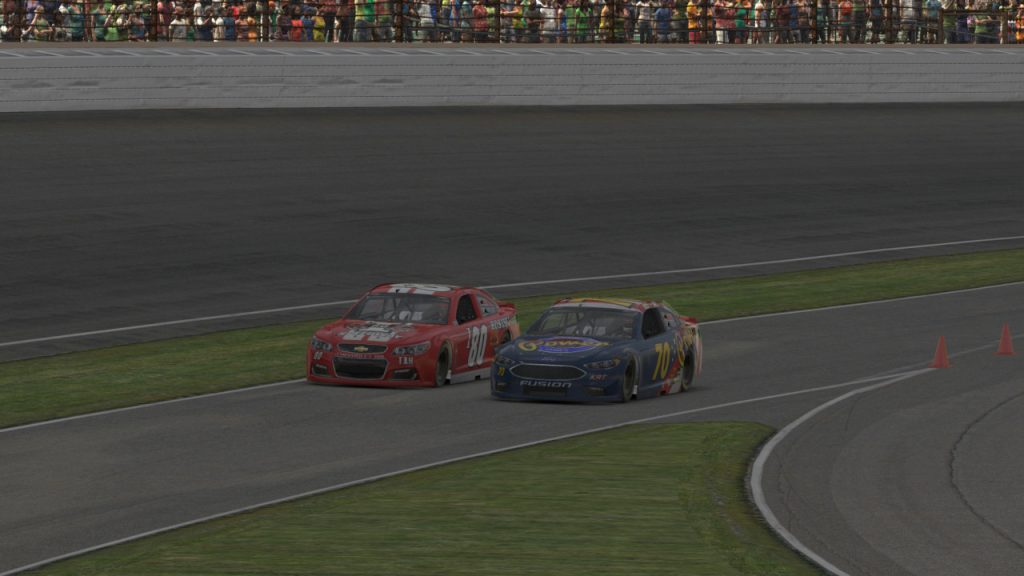
However, in this case, he let off and gave me the spot — perhaps returning my favor from earlier, or maybe out of similar self-preservation to avoid a crash.
Or maybe he was just confident in his own pace. He should have been. A few laps later, Mike got back around me and I couldn’t catch him before the final round of stops began.
Unfortunately for me, Matt had also caught up by this point and gotten between Mike and me. If the race had ended then, Mike would have been the champion. I needed to lead a lap, and it wouldn’t be as easy as I expected.
Tim pitted first and Mike followed him on the same lap — likely his only chance to win the race given the time lost during even one lap around Indy on older tires.
But Matt stayed out, and my fears of his spoiler role returned. Would he stay out long enough to run me out of fuel before I could lead a lap?
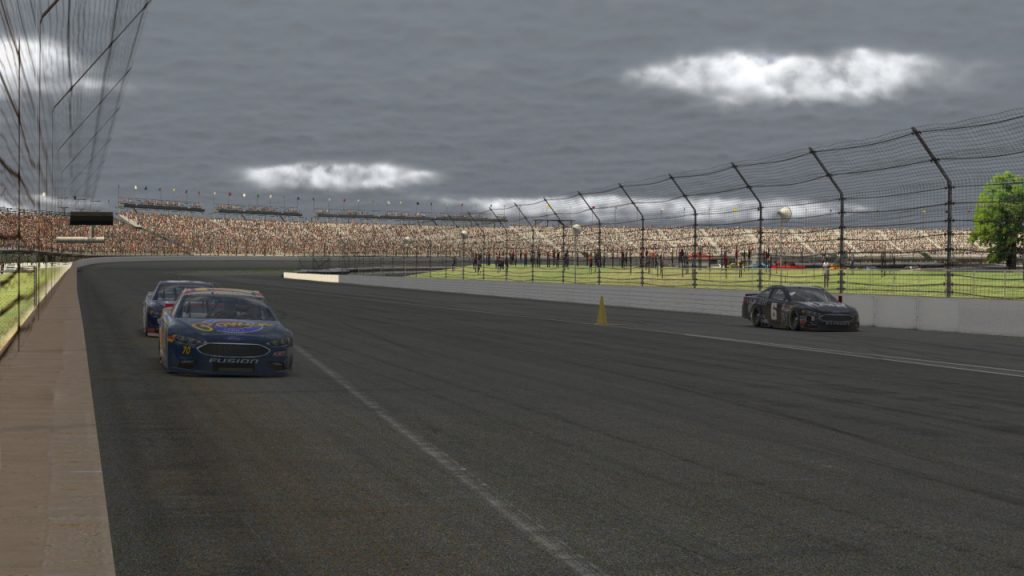
Luckily for me, he did not. He pitted one lap later, giving me the lead and a single but extremely valuable bonus point.
It was a strategy move reminiscent of NASCAR champion Alan Kulwicki. In the 1992 finale at Atlanta, he and his team had done the math to know that if he stayed out a few extra laps before making his final stop, he could lead the most laps and deny those extra points to his chief rival, Bill Elliott.
Ultimately, that decision cost Kulwicki a chance at the race win, in part because of a short pit stop with a light fuel fill. While Elliott cruised to the race win, Kulwicki conserved fuel running in second, but his strategic foresight had been enough for the championship.
In my case, after running two extra laps on old tires, I had given up any shot at outright beating my opponents on the track so that I could beat them in the standings. But it was far from a guarantee, and it carried two major risks.
If one of the drivers behind like Dean Moll — another potential spoiler — passed me during the cycle of stops, they might have gotten too far ahead for me to catch them in the final 20 laps. And if a caution had come out before I pitted, I would have restarted at the rear since Tim, Mike, and the other leaders were still on the lead lap.
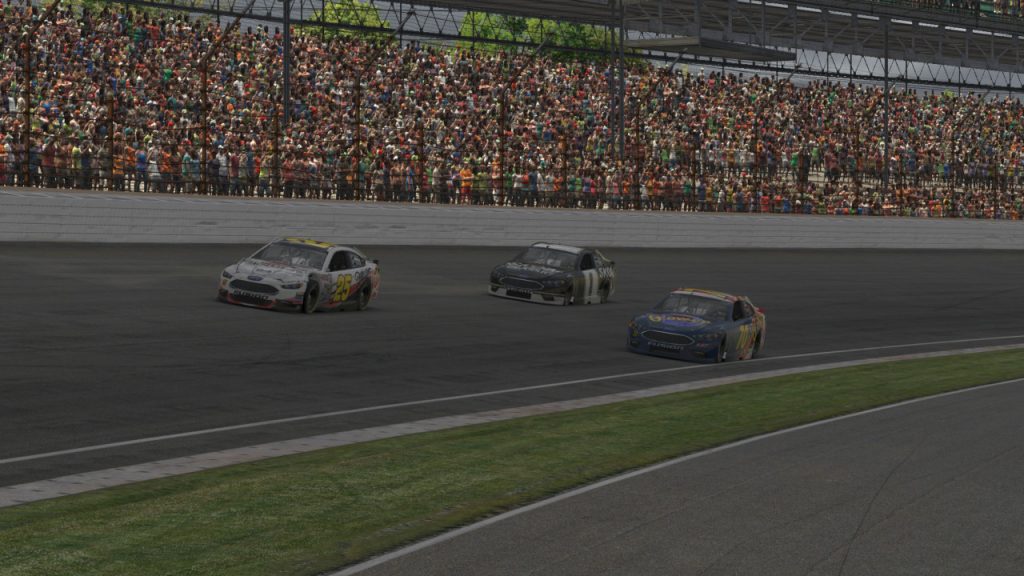
However, the clean race remained that way, and even though Dean did pass me during the pit sequence, I got around him shortly after my stop.
By this point, Mike was 8 seconds up the road, ahead of Matt and chasing down Tim. But Matt’s slightly fresher tires and better pace helped him get by Mike with 6 laps to go, and with Mike’s tires spent after a hard battle, he had nothing left to fight with.
The final margin between us was just two seconds, but more importantly, we were separated by just one point, and it was in my favor. And while Tim won the race and led the most laps, I finished four points in front of him.
No, a fourth-place finish wasn’t my best ever on an oval. In fact, it was tied for my sixth-worst finish in that 17-race season. But in a race where so much could have gone wrong — a hard battle backfiring, a strategy gamble flopping, or a spoiler living up to that title — I stayed cool and calculated.
In the end, it was worthy of a championship.
3. Power Series at Fontana – May 18, 2014
Two years before that race and my second Power Series title, I was still getting over losing my first championship.
While I can’t blame a single race for costing me a chance, a different result in any of the late-season races could have changed my fate, or at least given me more margin for error in a finale that turned into a head-to-head fight against a superior competitor, Kyle Taraska.
One of those races was at Auto Club Speedway, the 2-mile oval in Fontana, CA. It came down to fuel mileage and pit strategy, and I underperformed, finishing one spot behind Kyle without leading a lap.
The next Power Series season started in Fontana, and I was determined to make a fresh start while also fixing my failure from the previous race at that track.
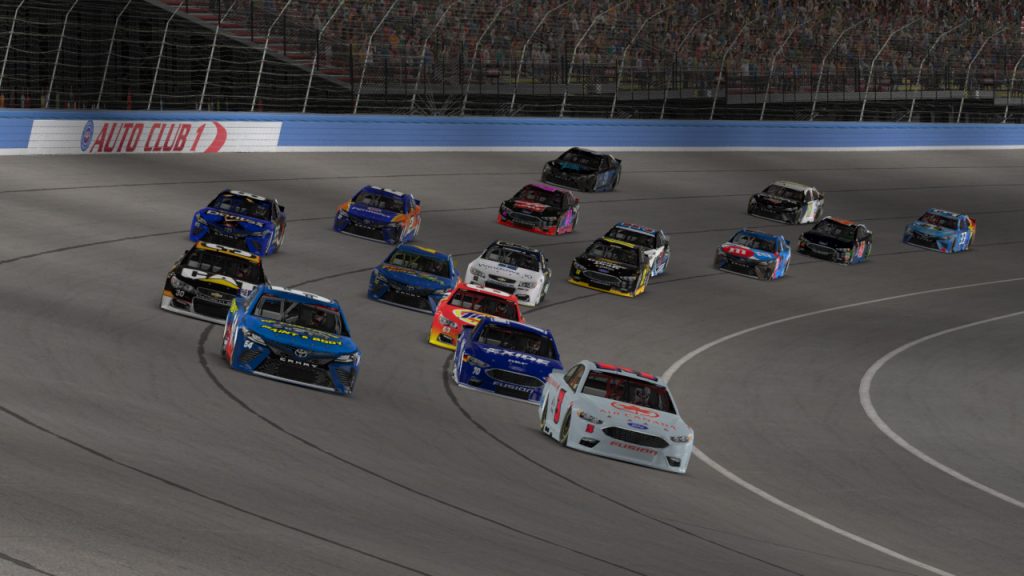
That effort began on a positive note, with a third-place qualifying run. Of course, I knew qualifying wouldn’t mean much on this wide track where the draft largely kept the field bunched up. The chances of someone breaking free for a runaway win were slim.
Early on, the pack settled into a single-file line, and I was content to run in third. My patience paid off on lap 12, as the two leaders simultaneously hit the wall off turn 4. That put the lead in my hands, and I stayed there until the first caution on lap 20.
A series of cautions then bunched up the field and shuffled the order, but even after losing spots, I managed to gain them back each time. I had a fast car, although I still hadn’t proven myself over a long run with green-flag stops — the same sort of ending that had cost me in the previous Fontana race.
I would get that second chance as this race went caution-free for the final 70 laps. And this time, I was off to the races.
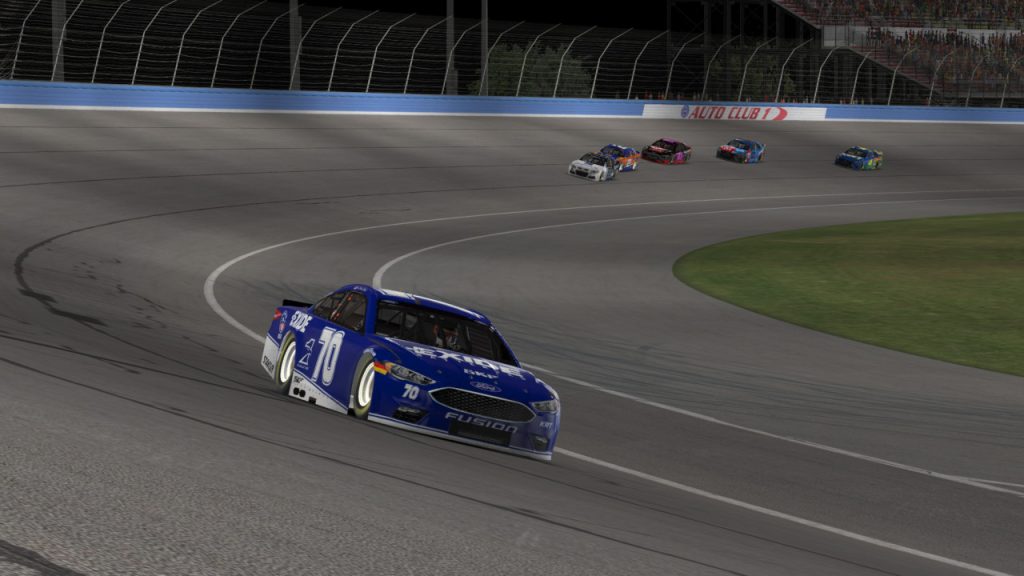
The field was full of worthy opponents, including Kyle, who had outrun me for the championship only one race earlier; Mike and Tim, who were always worthy opponents on any track; and a number of other drivers who all won races in the heyday of the Power Series.
However, while they battled behind me, I broke their draft, extended my lead, and executed a perfect green-flag stop in the run to the checkered flag.
My final margin was 13 seconds over second place and a full 20 seconds over Mike in third. In a fixed-setup series on a draft-friendly track, it was a dominant performance, and my best ever drive on an oval.
There isn’t much more to say about this race because it wasn’t a matter of math, strategy, or risk management. It was 125 laps of motivated, mistake-free driving that ended in victory lane.
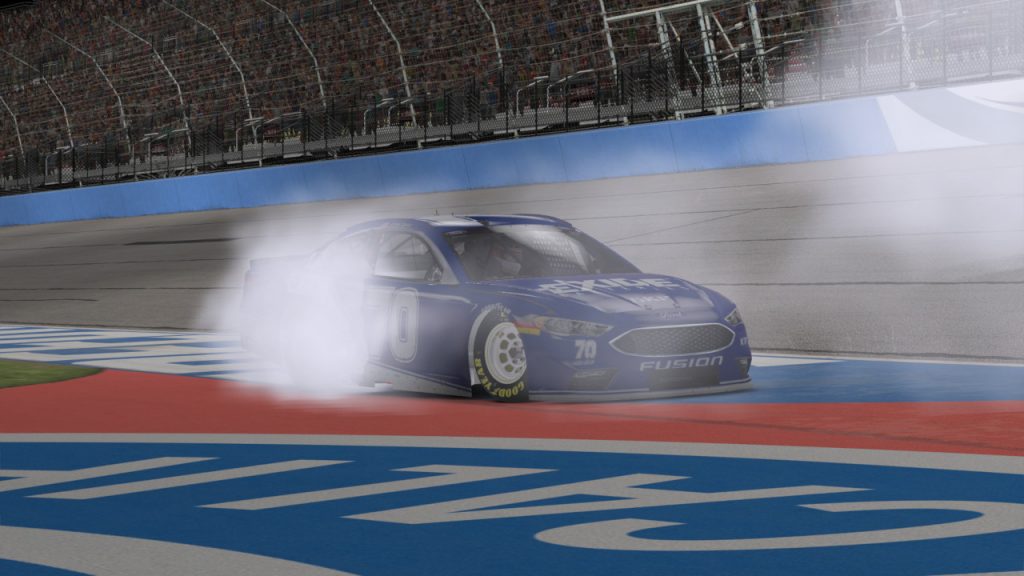
Looking back, it’s the first race that comes to mind when I think of having something to prove. And it wasn’t just proving it to my competitors. It was about proving something to myself.
While it came one race too late to win a championship, after losing that title, I started to second-guess myself, again thinking my oval results to date could have been just a fluke.
My success in that narrow two-year period, including my three stock car championships, still feels too good to be true sometimes. But at least my win at Fontana — one of the toughest oval tracks around — reminds me of how hard I worked to get to the top.